HTC Evo 3D Review
HTC Evo 3D
The phone for the person who truly wants it all. 3D camera, 3D screen, dual-core processor - the Evo 3D has the lot.
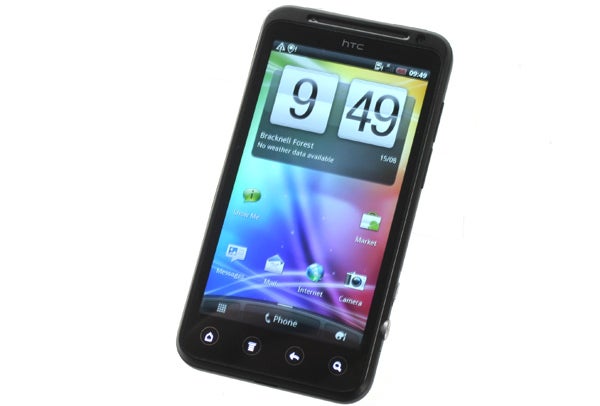
Verdict
Pros
- 3D can be impressive
- Large, high resolution screen
- Very fast
- HTC interface can be superb
Cons
- 3D can be horrible
- Large and bulky handset
- HTC interface can be frustrating
Key Specifications
- Review Price: £489.00
- 4.3in glasses-free 3D display
- Twin cameras for 3D shooting
- 1.2GHz dual core processor
- Android 2.3.4 operating system
It was only a matter of time until 3D found its way onto phones. And with the arrival of the LG Optimus 3D and the HTC Evo 3D, that time has come. Both pack dual cameras and the lenticular displays required to record 3D and play it back without glasses so on the move 3D fun is a true option. But are the phones any good? We’ve already looked at the LG and found it to be decent if a little large, so what of the HTC Evo 3D?
Well it doesn’t make an overly good first impression. Its design, while largely bland in its largely black-on-black stylings, is just the wrong side of quirky where it does break from the crowd. Obviously the twin cameras on the back don’t exactly help the aesthetic, and neither are we fans of the little circles round the touch buttons under the screen (responsive though they are). The mediocre design combined with the bulky dimensions (126 x 65 x 12.1mm) and hefty weight (170g) really leave you thinking straight away this is a phone that will only appeal through its power and features, if at all.
These things said, the design does incorporate some very appealing elements. The soft touch plastic back cover, with its angled grooves, provides a comfortable and secure grip, especially useful when taking photos. Even more useful is the addition of a proper shutter button with a stepped action for focusing then taking the shot. This is accompanied by a chunky metal slider switch for switching between 3D and 2D modes. We also like HTC’s recent addition of LEDs nestled behind the earpiece grill. These illuminate to show when the phone’s on charge, running low on charge or when you have a new message, just like a BlackBerry.
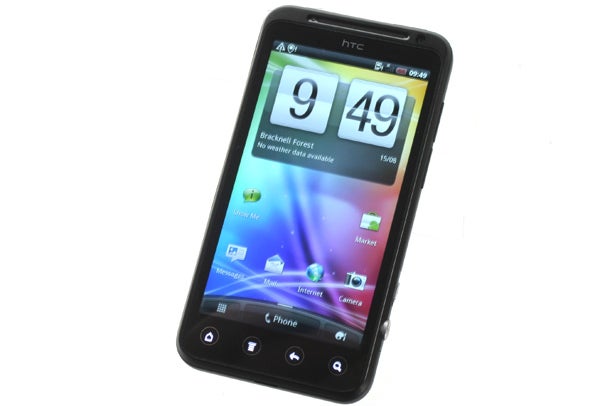
The phone feels well put together, as we’ve come to expect from HTC. There’s a black anodised aluminium section surrounding the screen while the back and body of the phone are made from sturdy plastics that exhibit little flex. And as you’d expect of a premium phone, the screen is glass-fronted.
Slide the slightly fiddly back cover off and there’s a reasonable-size replaceable 1730mAh battery alongside a microSD slot. This comes occupied by an 8GB card but can take cards up to 32GB in size, to bolster the phone’s in-built 1GB of storage.
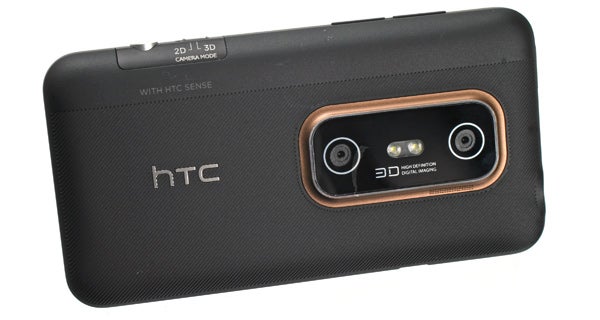
As ever, we’d prefer the power/screen lock button not to be on the top edge where it’s difficult to reach when holding the phone one-handed, but at least the headphone jack is conveniently positioned. On-body connectivity is finished off by a standard microUSB socket on the left edge, for charging and connecting the phone to your PC.
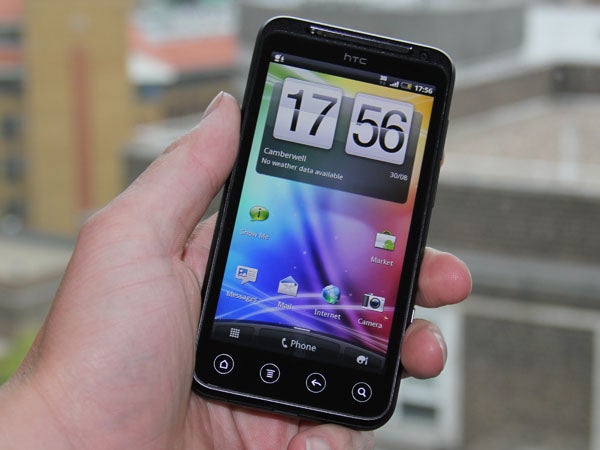
Turn the phone on and another positive hardware feature is immediately highlighted; the screen. We can actually take or leave the size of it (4.3in) as, despite its obvious advantages (bigger is better for watching video and gaming), these are largely countered by drawbacks such as it being difficult to reach the whole thing with a single thumb and it making the whole device large. No, what makes us like this panel is its high resolution of 540 x 960 pixels. This is actually still a few less than the pin-sharp iPhone 4 but it’s only if you peer very closely that you notice the difference.
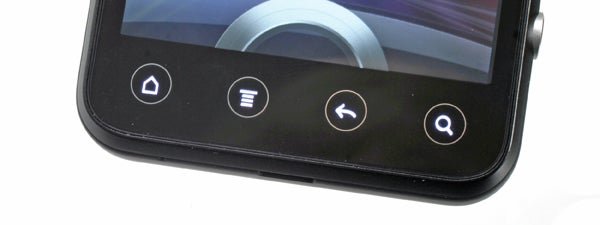
For this one reason, the HTC Evo 3D and a few others, including the HTC Sensation and Motorola Atrix, instantly have an advantage over the much-lauded Samsung Galaxy S II, which only has 480 x 800 pixels. The HTC Evo 3D also beats its 3D counterpart, the LG Optimus 3D, on this front.
It’s a reasonable quality LCD panel. It doesn’t have quite the contrast and viewing angles of the iPhone 4 but it competes pretty well with most alternatives, which is impressive considering there are the extra layers required to flip it into 3D mode. The Galaxy S II gets its own back here though, its Super AMOLED 2 screen trumping all contenders for sheer colour vibrancy and viewing angles.
Also impressive is the speed of the HTC Evo 3D. It packs in a 1.2GHz (yeah, that’s right, 1GHz is so yesterday) dual-core CPU and 1GB of RAM, which combined make this phone fly. There are subtle differences in performance between all the chips these dual-core smartphones use but in practice you’ll not notice. This phone and its brethren will romp through whatever task you throw at them, making general navigation instantly responsive, making games look great and play superbly and allowing you to truly multi-task without slow down (up to a point).
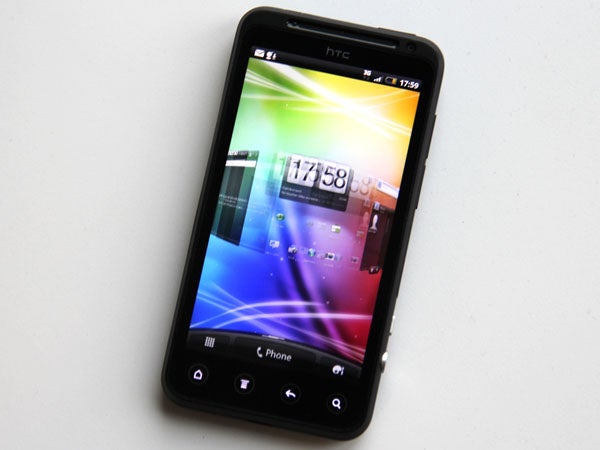
It’s just as well as HTC has gone to town with its homescreen jiggery pokery to make use of this power. If it’s raining the screen is covered with rain drops that are swiped away by a digital windscreen wiper, rotate the screen slowly and it appears that you’re truly rotating a 3D world of homescreens, while flicking the homescreen quickly will result in a veritable carousel of homescreens spinning before your eyes. It’s all very clever and all very pointless. We’ve been impressed with HTC’s Sense UI over the last few years as its pioneered innovations and improvements to the Android interface but with the latest version it has gone a bit far.
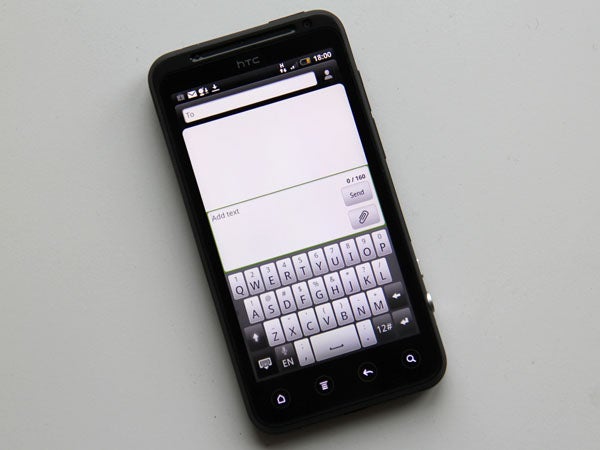
It’s not just because of the fancy stuff, either. We’ve always found the HTC keyboard looks a little cluttered, displaying secondary functions on the keys at all times, and we don’t like the way the main menu is split up into multiple pages rather than one long list. It’s not that it’s outright bad – there are some rather nice elements, which we’ll mention in a moment, but it does rather exemplify precisely why many of us are calling for Google to tighten its control on Android and stop third-party manufacturers tweaking the look and feel too much. We don’t want innovation stifled completely but some of the differentiating changes made by these companies do feel very much like change for changes sake.
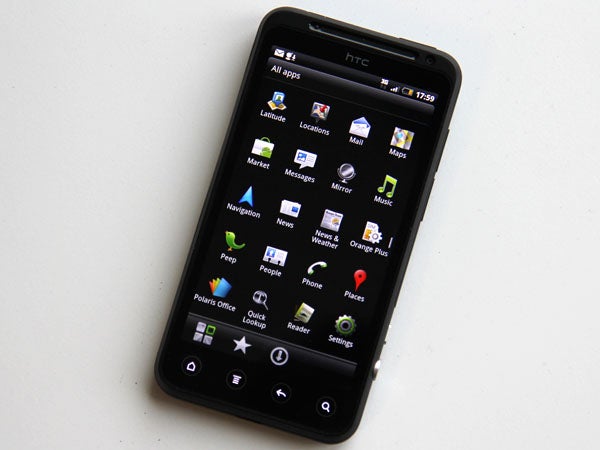
As for those nice elements, we like the addition of Quick Settings and Connection Mode in the notifications drop down menu and have always liked the integrated dialler and contacts list that’s accessed with a tap of the Phone button – it really is the quickest and easiest way to start a call. We also like the unlock screen that lets you drag one of four customisable icons into the circle at the bottom of the screen to jump straight into that app – it saves more time than you might realise. And, the old ability to mute the phone simply by flipping it over is always welcome.
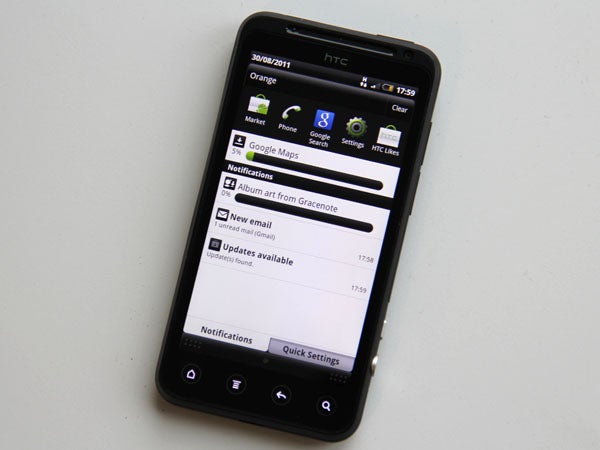
HTC has also added its Scenes, which are essentially desktop themes that change the background picture and the default selection of widgets and shortcuts. They’re a bit gimmicky but there are some nice backgrounds in there.
Minor quibbles aside, thanks to its use of Android 2.3.4 this is a powerful yet easy to use phone that has all the usual advantages therein – there are plenty of apps in the Market, you’ve a browser that supports Adobe Flash and a wealth of customisability. However, one thing HTC doesn’t make prominent is the phone’s 3D capabilities.
There is essentially nothing in the way of additional 3D content, apps or features. You can’t download 3D movies, there’s no equivalent of a 3D PhotoBooth to muck about with 3D images of you or your friends. All you get is the gallery for viewing pictures, the camera and compatibility with 3D YouTube videos. Admittedly the latter is arguably enough to begin with and adding much more could simply have resulted in a bunch of gimmicky detritus but it is startling how little the feature is used, which is a shame as it can work quite well.

Switch the screen to 3D mode (you shouldn’t leave it in 3D mode as this drains the battery) and open up the gallery or camera and the initial impression is… well, not wholly impressive. Concentrate too hard and you’ll have an eyestrain-induced headache in mere moments. This is because there’s a definite sweet spot of about 30cm from your face and with the screen directly in front of you – this can’t comfortably be a shared experience. Once you’ve found this spot and relaxed your eyes into it, the effect it quite impressive. Clearly you’re not going to get cinema levels of quality but nonetheless you can have some fun with it.
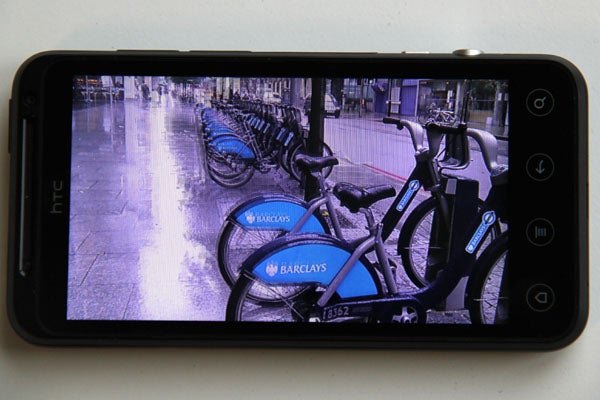
Firing up some 3D YouTube clips really did highlight how much you’re sacrificing in terms of sharpness, contrast, and overall visual enjoyment to have that 3rd dimension but again there is a certain level of enjoyment to be had.
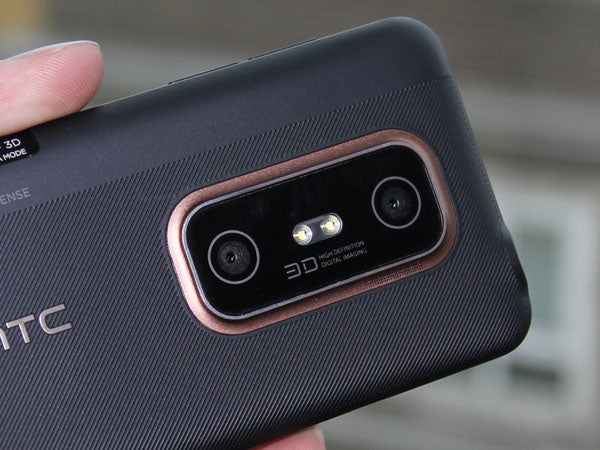
One area that can really catch you out is shooting video or capturing some images. Here, when the camera is out of focus, the 3D effect is at its worst and it really is a struggle to use sometimes but in short bursts it’s okay. If you’re shooting video you’re also limited to ”only” 720p video.
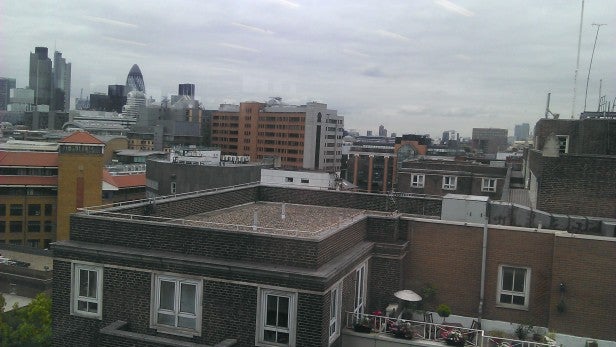
Sadly, switching to 2D mode reveals a fairly lacklustre standard camera performance. While some high-end smartphones are now offering Full HD 1080p video, this one only has 720p and likewise it only packs in a 5-megapixel stills camera, compared to the eight megapixels of some models. The difference is palpable as well. The loss of detail is definitely noticeable and this is on top of HTCs continued mediocrity when it comes to colour reproduction – images look at bit washed-out, colours are inaccurate, and there’s a distinctly blotchy effect, almost as if the images were painted.
The HTC Evo 3D doesn’t hold up all that well when it comes to general multimedia, either. It didn’t recognise the MOV, MKV or DivX files we threw at it, all of which the Samsung Galaxy S II can cope with – you’ll have to convert your files into .mp4 or .avi to have any luck. Most image formats are handled fine, though more typically fancy audio formats like FLAC aren’t supported. There’s also a tiny amount of hiss during quiet moments. The loud speaker doesn’t particularly make up for this either with a very middling performance with bass lacking and overall volume limited. At least you get a quick player appear in the notifications bar and lock screen when music’s playing.
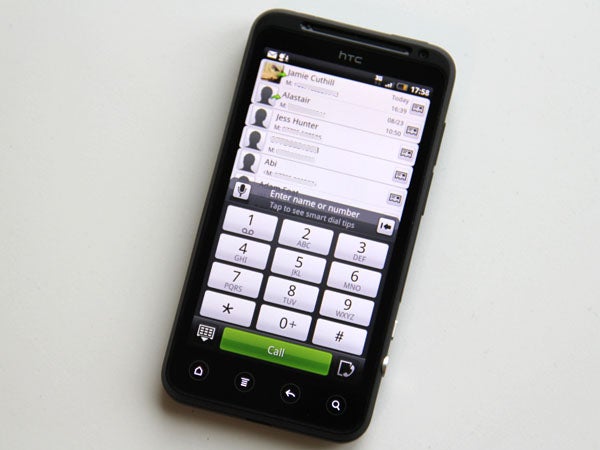
When it comes to the more serious side of life, the Evo 3D comes up smelling of roses, though. Making and taking calls and managing your contacts is easy thanks to the inherent powers of Android and the social networking integration HTC has added. It’s near-effortless to bring together all your Facebook, Twitter, email and phone contacts into one easy-to-read entry.
HTC has also added a few apps of its own including its Watch video download service. This is a reasonably easy to use service with a few premium titles on offer but overall the selection is still far off being sufficient. There’s also HTC’s decent ebook reader called Reader and HTC Likes, a portal for apps that HTC has either developed or recommends. None are exactly compelling.
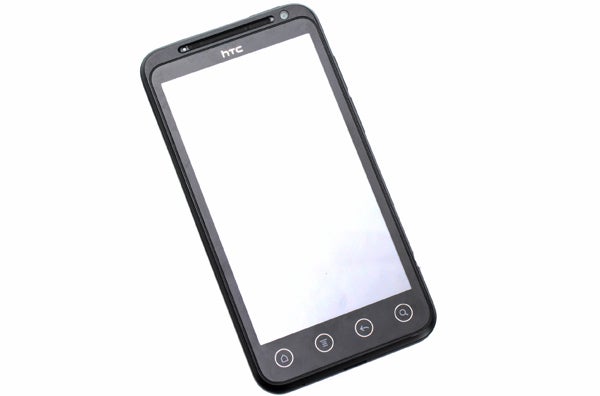
Call quality threw up not causes for concern while all the basics like GPS worked well, and signal reception seemed on par with the smarpthone norm. What did let the side down was battery life. The combination of that 3D screen, the size of said screen, and the sheer power of the phone means this is a device you’ll simply have to charge every night. In contrast many other high-end smartphones will last a couple of days if you’re not too heavy a user.
”’Verdict”’
The HTC Evo 3D is clearly a very capable handset, packing-in just about every current key feature, including of course its 3D camera and screen. As such it ranks very highly if you’re simply after a top-spec powerhouse. However, we’re just not wholly convinced. Obviously there’s the plain fact that 3D is a bit of a gimmick, and that the 2D camera quality suffers because of it. The styling and size of the phone also put us off slightly too. And finally we find HTC’s implementation of Android more and more cumbersome, with it refusing to keep things simple. Unless you’re desperate for a fully 3D future there are better alternatives.
How we test phones
We test every mobile phone we review thoroughly. We use industry standard tests to compare features properly and we use the phone as our main device over the review period. We’ll always tell you what we find and we never, ever, accept money to review a product.
Trusted Score
Score in detail
-
Performance 9
-
Design 7
-
Value 8
-
Features 9
General
| Operating System | Android OS |
| Height (Millimeter) | 126mm |
| Width (Millimeter) | 65mm |
| Depth (Millimeter) | 12.1mm |
| Weight (Gram) | 170g |
Display
| Screen Size (inches) (Inch) | 4.3in |
| Screen Resolution | 540 x 960 |
| Touchscreen | Yes, glass capacitive |
Battery
| Talk Time (Minute) | 465m |
| Standby Time (Hour) | 420hr |
Storage
| Internal Storage (Gigabyte) | 1GB |
| Camera (Megapixel) | 5 Megapixel |
| Front Facing Camera (Megapixel) | Yes Megapixel |
| Camera Flash | twin LED |
Connectivity
| Bluetooth | Yes |
| WiFi | Yes |
| 3G/4G | Yes |
| 3.5mm Headphone Jack | Yes |
| Charging/Computer Connection | microUSB |
Processor and Internal Specs
| CPU | 1.2GHz dual-core Samsung Orion |
Misc
| App Store | Yes |
| GPS | Yes |

